The sukkah is a structure for the Jewish celebration
Sukkot at the end of Yom Kippur. It is to be dwelt in
and prayed in during this time and then is immediately
dismantled or the sekhakh (foliage strewn on top) is
removed on the last day of the ceremony.
Sukkot commemorates the forty-year period during which
the children of Israel were wandering in the desert,
living in temporary shelters.
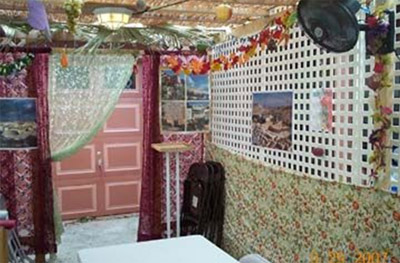
The
Festival of Sukkot begins on Tishri 15, the fifth day
after Yom Kippur. Sukkot in 2008 will start on Tuesday,
the 14th of October and will continue for 7 days until
Monday, the 20th of October.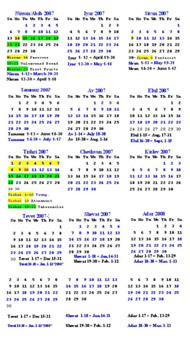
Note that in the Jewish calendar, a holiday begins on
the sunset of the previous day, so observing Jews will
celebrate Sukkot on the sunset of Monday, the 13th of
October.
It is quite a drastic transition, from one of the most
solemn holidays in our year to one of the most joyous.
Sukkot is so unreservedly joyful that it is commonly
referred to in Jewish prayer and literature as Z'man
Simchateinu , the Season of our Rejoicing.
Sukkot is the last of the Shalosh R'galim (three pilgrimage
festivals). Like Passover and Shavu'ot, Sukkot has a
dual significance: historical and agricultural. Historically,
Sukkot commemorates the forty-year period during which
the children of Israel were wandering in the desert,
living in temporary shelters. Agriculturally, Sukkot
is a harvest festival and is sometimes referred to as
Chag Ha-Asif , the Festival of Ingathering.
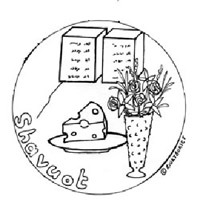
Definition
The word "Sukkot" means "booths,"
and refers to the temporary dwellings that the Jewish
People are commanded to live in during this holiday
in memory of the period of wandering. Our sukkahs can
be either dismantled at the end of the holiday, or left
standing year-round. The roofs are mostly open, to let
the elements in freely, while the 2x6 rafters provide
shade from the worst of the sun. Partial sun blockage
provides a surprising amount of comfort.
The Hebrew pronunciation of Sukkot is "Sue COAT," but
is often pronounced as in Yiddish, to rhyme with "BOOK
us." The name of the holiday is frequently translated
"Feast of Tabernacles," which, like many translations
of Jewish terms, isn't very useful. This translation
is particularly misleading, because the word "tabernacle"
in the Bible refers to the portable Sanctuary in the
desert, a precursor to the Temple, called in Hebrew
"mishkan." The Hebrew word "sukkah" (plural: "sukkot")
refers to the temporary booths that people lived in,
not to the Tabernacle.
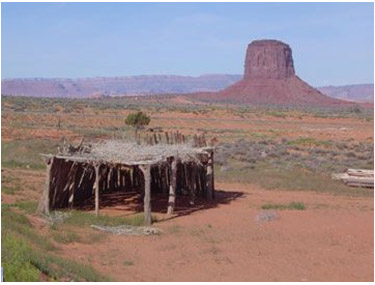
Why a Sukkah?
In honor of the holiday's historical significance, the
Jewish People are commanded to dwell in temporary shelters,
as our ancestors did in the wilderness. The temporary
shelter is referred to as a sukkah (which is the singular
form of the plural word "sukkot"). Like the word sukkot,
it can be pronounced like Sue-KAH, or to rhyme with
Book-a.
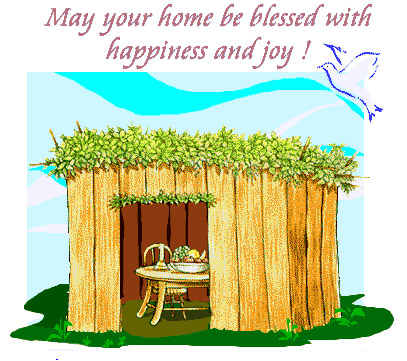 The
sukkah is great fun for the children. Building the sukkah
each year satisfies the common childhood fantasy of
building a fort, and dwelling in the sukkah satisfies
a child's desire to camp out in the backyard. The commandment
to "dwell" in a sukkah can be fulfilled by simply eating
all of one's meals there; however, if the weather, climate,
and one's health permit, one should spend as much time
in the sukkah as possible, including sleeping in it. The
sukkah is great fun for the children. Building the sukkah
each year satisfies the common childhood fantasy of
building a fort, and dwelling in the sukkah satisfies
a child's desire to camp out in the backyard. The commandment
to "dwell" in a sukkah can be fulfilled by simply eating
all of one's meals there; however, if the weather, climate,
and one's health permit, one should spend as much time
in the sukkah as possible, including sleeping in it.
How do I build a Sukkah?
A sukkah must have at least two and a half walls covered
with a material that will not blow away in the wind.
The "walls" of the sukkah do not have to be solid; canvas
covering tied or nailed down, or held in place by pring
clips, is acceptable 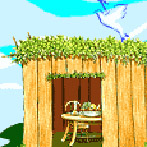 and
quite common in the United States. A sukkah may be any
size, so long as it is large enough for you to fulfill
the commandment of dwelling in it. The roof of the sukkah
must be made of material referred to as sekhakh (literally,
covering). To fulfill the commandment, sekhakh must
be something that grew from the ground and was cut off,
such as tree branches, corn stalks, bamboo reeds, sticks,
or two-by-fours. Sekhakh must be left loose, not tied
together or tied down. Sekhakh must be placed sparsely
enough that rain can get in, and preferably sparsely
enough that the stars can be seen, but not so sparsely
that more than ten inches is open at any point or that
there is more light than shade. The sekhakh must be
put on last. Note: You may put a water-proof cover over
the top of the sukkah when it is raining to protect
the contents of the sukkah, but you cannot use it as
a sukkah while it is covered and you must remove the
cover to fulfill the mitzvah (Hebrew: "divine commandment")
of dwelling in a sukkah. and
quite common in the United States. A sukkah may be any
size, so long as it is large enough for you to fulfill
the commandment of dwelling in it. The roof of the sukkah
must be made of material referred to as sekhakh (literally,
covering). To fulfill the commandment, sekhakh must
be something that grew from the ground and was cut off,
such as tree branches, corn stalks, bamboo reeds, sticks,
or two-by-fours. Sekhakh must be left loose, not tied
together or tied down. Sekhakh must be placed sparsely
enough that rain can get in, and preferably sparsely
enough that the stars can be seen, but not so sparsely
that more than ten inches is open at any point or that
there is more light than shade. The sekhakh must be
put on last. Note: You may put a water-proof cover over
the top of the sukkah when it is raining to protect
the contents of the sukkah, but you cannot use it as
a sukkah while it is covered and you must remove the
cover to fulfill the mitzvah (Hebrew: "divine commandment")
of dwelling in a sukkah.
An easier way to build
your Sukkah…
The sukkah is great fun for the children. Building the
sukkah each year satisfies the common childhood fantasy
of building a fort, and dwelling in the sukkah satisfies
a child's desire to camp out in the backyard. The commandment
to "dwell" in a sukkah can be fulfilled by simply eating
all of one's meals there; however, if the weather, climate,
and one's health permit, one should spend as much time
in the sukkah as possible, including sleeping in it.
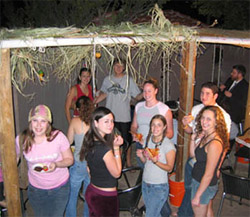
You can buy a do-it-yourself sukkah from us at Baldwin
Pergolas. We have many designs available, at a wide
array of prices, or we can even custom-design one to
your specifications. A pergola is very much like a sukkah
in structure. Our pergolas are finely crafted and often
are left up year-round.
It is common practice, and highly commendable, to decorate
the sukkah. In the northeastern United States, people
of the Jewish faith commonly hang dried squash and corn
in the sukkah to decorate it, because these vegetables
are readily available at that time for the American
holidays of Halloween and Thanksgiving. Many families
hang artwork drawn by the children on the walls. Building
and decorating a sukkah is a fun family project, much
like decorating the Christmas tree is for Christians.
It is a sad commentary on modern American Judaism that
most of the assimilated Jews who complain about being
deprived of the fun of having and decorating a Christmas
tree have never even heard of Sukkot.
History of the American
Sukkah
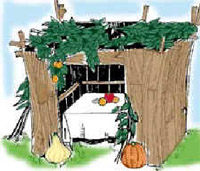 Many
Americans, upon seeing a decorated sukkah for the first
time, remark on how much the sukkah (and the holiday
generally) reminds them of Thanksgiving. This may not
be entirely coincidental: I was taught that our American
pilgrims, who originated the Thanksgiving holiday, borrowed
the idea from Sukkot. The pilgrims were deeply religious
people. When they were trying to find a way to express
their thanks for their survival and for the harvest,
they looked to the Bible for an appropriate way of celebrating
and found Sukkot. This is not the standard story taught
in public schools today (that a Thanksgiving holiday
is an English custom that the Pilgrims brought over),
but the Sukkot explanation of Thanksgiving fits better
with the meticulous research of Mayflower historian
Caleb Johnson, who believes that the original Thanksgiving
was a harvest festival (as is Sukkot), that it was observed
in October (as Sukkot usually is), and that Pilgrims
would not have celebrated a holiday that was not in
the Bible (but Sukkot is in the Bible). Although Mr.
Johnson claims that the first Thanksgiving was "not
a religious holiday or observance," he apparently
means this in a Christian sense, because he goes on
to say that the first Thanksgiving was instead "a
harvest festival that included feasts, sporting events,
and other activities," concepts very much in keeping
with the Jewish religious observance of Sukkot. Many
Americans, upon seeing a decorated sukkah for the first
time, remark on how much the sukkah (and the holiday
generally) reminds them of Thanksgiving. This may not
be entirely coincidental: I was taught that our American
pilgrims, who originated the Thanksgiving holiday, borrowed
the idea from Sukkot. The pilgrims were deeply religious
people. When they were trying to find a way to express
their thanks for their survival and for the harvest,
they looked to the Bible for an appropriate way of celebrating
and found Sukkot. This is not the standard story taught
in public schools today (that a Thanksgiving holiday
is an English custom that the Pilgrims brought over),
but the Sukkot explanation of Thanksgiving fits better
with the meticulous research of Mayflower historian
Caleb Johnson, who believes that the original Thanksgiving
was a harvest festival (as is Sukkot), that it was observed
in October (as Sukkot usually is), and that Pilgrims
would not have celebrated a holiday that was not in
the Bible (but Sukkot is in the Bible). Although Mr.
Johnson claims that the first Thanksgiving was "not
a religious holiday or observance," he apparently
means this in a Christian sense, because he goes on
to say that the first Thanksgiving was instead "a
harvest festival that included feasts, sporting events,
and other activities," concepts very much in keeping
with the Jewish religious observance of Sukkot.
Our Sukkahs…
SIMPLEST SUKKAH SKU/ITEM NUMBER: SUKKAHPB12X12
Our simplest design, this sukkah spans 12 feet by 12
feet, with an 8'x8' post placement. We can also add
curtain rods all around, with curtains, and a retractable
awning, if desired.
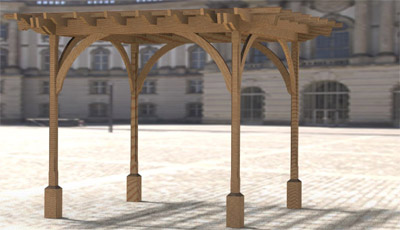
Sukkah in the Courtyard.…$4244 without the extras...
Style: Post and Beam
Configuration: Freestanding
Overall Depth: 12 foot, 0 inch
Overall Width: 12 foot, 0 inch
Overhang: 24
Height: 8 feet tall
Mounting Surface: Patio over gravel
Rafter Tail Architecture: Contoured rafter tails
Lumber: Knotty Entablature
Beams: Extra large 2x8
Finish: Sealed with Olympic
Legs: 4 4x4 Posts
Gussets: 8 Arched gussets
Garden Room Sukkah
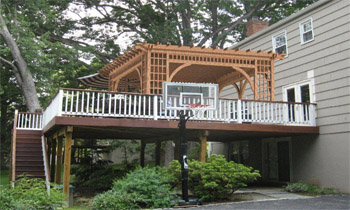
More elaborate designs include lattice panels,
curtains (not shown), rope-lighting along the headbeams,
and can be used year-round once the se'chach is removed.
This one is 20' by 16', with 24" overhangs all around.
" Made entirely from Western Red Cedar, Coastal grade,
imported from British Columbia "
Shown stained and sealed with Olympic Maximum sealant.
This model, with all the extras, goes for $13,934
|
